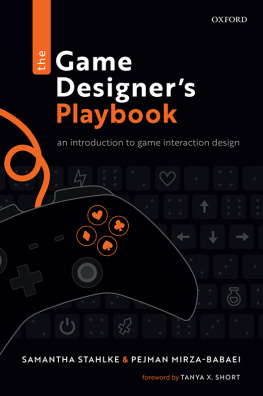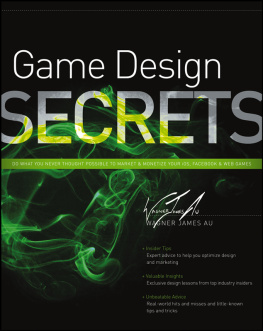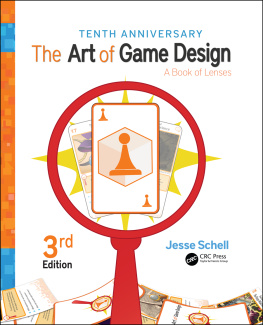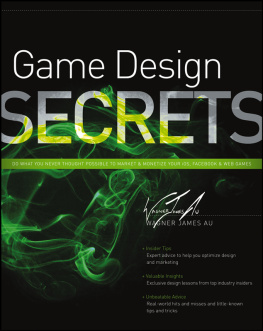The Kobold Guide to Board Game Design
L EAD A UTHOR AND E DITOR: Mike Selinker E SSAY A UTHORS: Rob Daviau, James Ernest, Matt Forbeck,
Richard Garfield, Dave Howell, Steve Jackson, Richard C. Levy,
Andrew Looney, Michelle Nephew, Paul Peterson, Lisa Stenson,
Jeff Tidball, Teeuwynn Woodruff, Dale Yu C OVER A RTIST: John Kovalic P ROOFREADER: Miranda Horner L AYOUT: Anne Trent P UBLISHER: Wolfgang Baur The Kobold Guide to Board Game Design 2011 Open Design LLC All Rights Reserved. Reproduction of this book in any manner without express permission from the publisher is prohibited. OPEN DESIGN LLC
P.O. Box 2811
Kirkland, WA 98083 WWW.KOBOLDQUARTERLY.COM Open Design and the Open Design logo are trademarks of Open Design LLC.

Foreword
We settled into Noodle Boat for a nice Thai meal. Around the table, everyone placed their orders. Asked what level of spice they wanted, the other five people each said some number of stars between one and three. The waitress then asked me.
How many stars do you have? I asked.
Twenty-five, she said, earning the gasps of all present.
Okay, Ill go with eight.
Immediately I was besieged. Eight?! my teammates demanded. Why, you need to have a minimum of twelve or thirteen. Be at least half a man!
I dont see any of you changing your orders, I said.
But how, the cacophony continued, could you pick eight?
Because Im a game designer , I thought to myself. The scale that my colleagues had chosen from was, at least for pasty-faced Pacific Northwesterners, built on a scale from one to four. Everyone who walked in that door knew that scale: one was mild, four was hot. The restaurant knew that if one and four were both varieties of mild, half their customers would never return. In that game of guess how much spice is in your foodbecause, really, thats the game you play when you try a new Thai restaurantone was low and four was high. My strategy is always the same in that game: go for high.
What I had done was expose the existence of a different game, in which four was still high but twenty-five was unimaginably high. The existence of that game did not invalidate the first game. In this new game, I played conservatively. And let me tell you, eight was hot . Many Scovilles died to make that meal. Because I had a very spicy dinner that still had flavor and nuance, I won that game.
The people who youll find in the pages of this book know how to play and win games such as this. Thats because they design them. In here youll find the designers of many of your favorite games, and a few whose games you might not have heard of, but should, because theyre awesome. They also can write, which is not a given with game designers. They know whereof they speak.
By the end of this book, you will also know whereof they speak. Thats because theyre all willing to tell you how they work. If you want a career like theirs, you could do a lot worse than following their leads. Ive collaborated with all of them in one capacity or another. If youre lucky, you will too.
In the course of these essays, well cover many subjects. Some are more philosophicalhow to think, how to prepare, how to evaluate. Some are more practicalhow to playtest, how to balance, how to prototype. But wherever they fall on that axis, all matter. If you take the time at each step of your design process to consider each writers words, by your last step you will have done everything better.
The Kobold-in-Chief, Wolfgang Baur, wanted a selection of designers with wildly differing experiences and voices. Some are mass market and some are hobby. Some have stayed within one field and others have done a little bit of everything. They often disagree with each other. You might wonder how you will choose between the advice of one and the advice of another. Youre smart. Youll figure it out.
But enough promises. Lets get to work.
Mike Selinker
Seattle, Washington
Contents
by James Ernest by Richard Garfield by Jeff Tidball by Matt Forbeck by Mike Selinker by Andrew Looney by Rob Daviau by Lisa Stenson by Mike Selinker by James Ernest by Dale Yu by Paul Peterson by Dave Howell by Mike Selinker by Teeuwynn Woodruff by Steve Jackson by Dale Yu by Richard C. Levy by Michelle Nephew
Part 1: Concepting
In which we figure out what games to make, who will play those games, and what impressions we will leave them with.
The Game Is Not the Rules
by James Ernest
Mike here. Its my job, as compiler and editor of this book, to give you an understanding of what will be in the book, whose job is to give you an understanding of what the game design process is like. So Im doing that by getting out of the way. Im going to introduce you to some of the finest minds in the business, with a little paragraph like this one in front of each essay. Well start with a topic-setting essay by James Ernest, my primary board and card game design partner. He said what follows way better than I could. Listen up.
A game is a way to play by a set of rules. Good rules help you find the fun. Bad rules obscure it. But the rules are not, themselves, the fun. It sounds obvious when you say it like that. But game designers of all skill levels fall into the trap of believing that the mechanics and the game are the same thing.
A game is a whole package. It is not a collection of parts. A game can have a theme, a mechanic, a brand, a hook, a lifestyle. But these parts are not interchangeable with other games. Its only as a complete unit that the game resonates, draws attention, engages players, and becomes a part of their lives.
If you want to invent a new game, you have to do better than just improving on existing rules. You need to consider why the game, as a whole, will get into players heads.
C OMPELLING GAME MECHANICS
Recently I was on a panel of game experts at a local gaming convention. Someone in the audience asked, What would you consider to be compelling game mechanics? I had to answer, There is something wrong with your question.
Game mechanics are like the parts of a watch. What would you consider to be compelling watch parts? I could tell you about bridges, wheels, and springs all day. But youd be no closer to understanding what makes a good watch. Nobody buys a watch because of its gears. Even the people who say they do.
Game mechanics are like watch gears. A compelling game mechanic only makes sense in context. Transplant that mechanic into another game, and there is no guarantee that it will work.
This is not to say that games cant borrow mechanics from each other. They certainly do. But blindly transplanting pieces from one mechanism to another is a terrible way to design. You cant just throw a bunch of random watch pieces together and expect them to tell time. You must have a plan.
When you break a game down into its component parts, you can certainly learn about that game. But you cant apply very much of what youve learned toward creating a new one. Breaking something down into components really only teaches you about the components; it obscures your perception of the whole. A map of Spain tells you very little about the New World.
T HE CRITICAL APPROACH
Its hard to be a creator when all you have is critical skill. Thats why the jobs of critic and creator rarely overlap.
If I ask the question all good watches are (blank), what do you say? The whiteboard is empty. Begin.
They have hands. They have a face. They have numbers. They are precise. Accurate. Fashionable. Affordable. They tell time. Uh, they have gears. They use electricity. They have an alarm. And so on.
Keep throwing things out there, and Im sure I can think of a counterexample for each one. A watch without hands, for example. And I can also think of something that is not a watch that has most of these things. In fact, a varsity football player makes it most of the way through the list.
Next page





![Jesse Schell [Jesse Schell] - The Art of Game Design, 2nd Edition](/uploads/posts/book/119435/thumbs/jesse-schell-jesse-schell-the-art-of-game.jpg)
![Wagner James Au [Wagner James Au] - Game Design Secrets](/uploads/posts/book/119431/thumbs/wagner-james-au-wagner-james-au-game-design.jpg)
![Ethan Ham [Ethan Ham] - Tabletop Game Design for Video Game Designers](/uploads/posts/book/119417/thumbs/ethan-ham-ethan-ham-tabletop-game-design-for.jpg)

